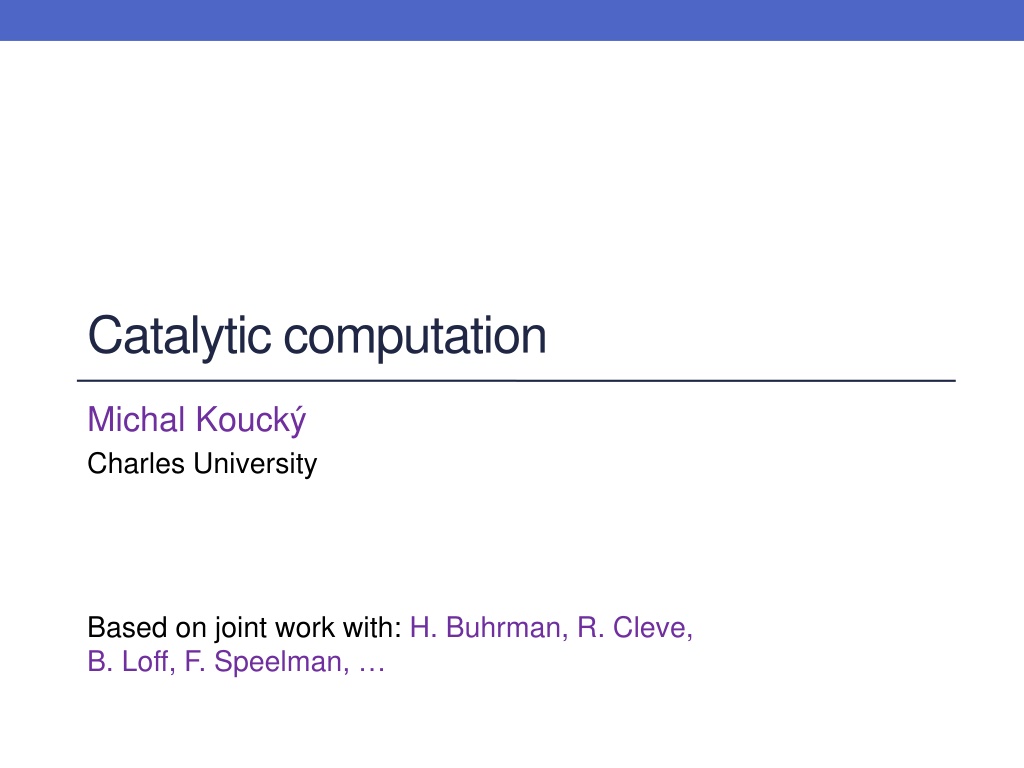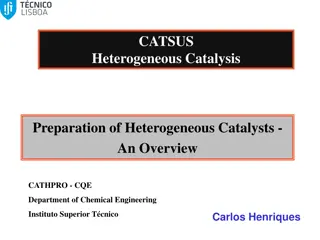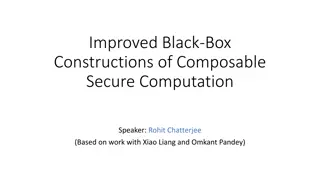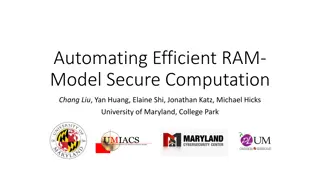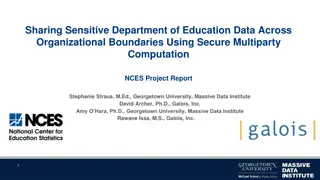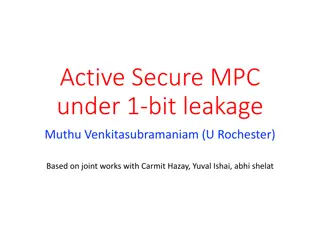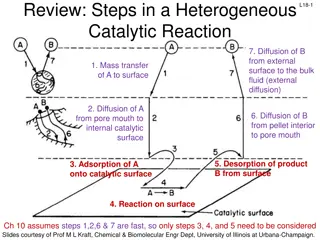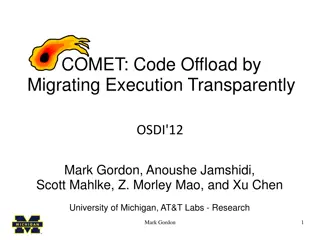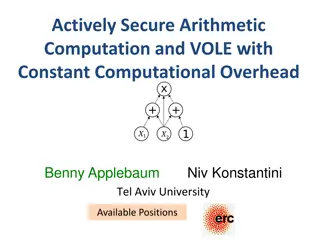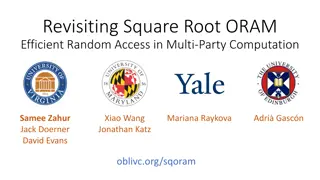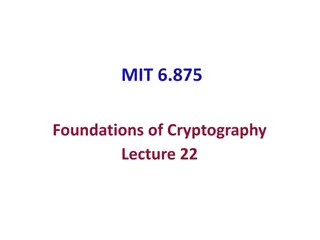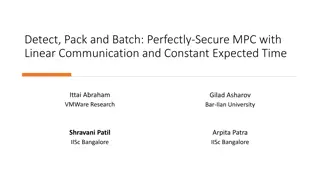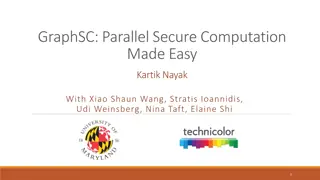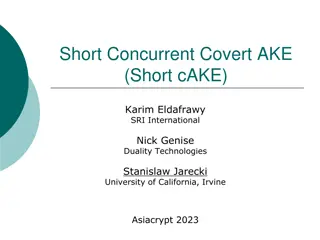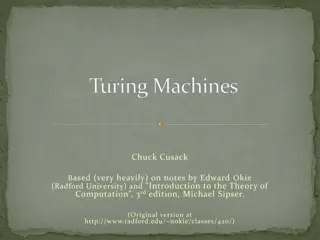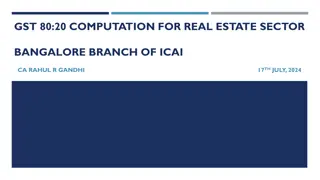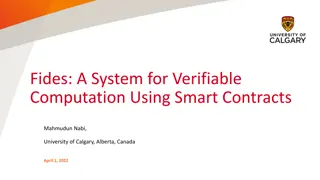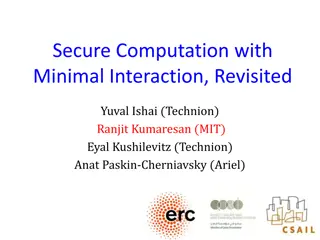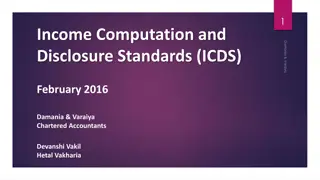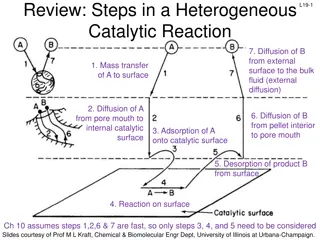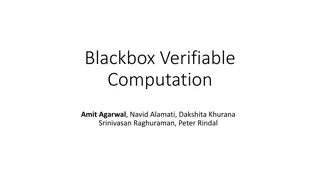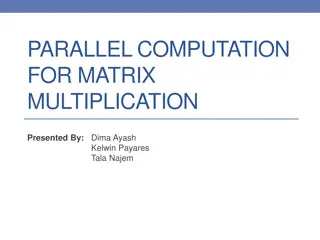Catalytic computation
Catalytic computation, space hierarchy theorem, and reversible computation are explored in collaboration with researchers from Charles University. The interplay between work space, auxiliary tapes, and catalyst space is investigated to understand the power and limitations of different computational models. Reversible computation, studied since the 1960s, is of interest to physicists for its energy efficiency and fundamental properties.
Uploaded on Feb 17, 2025 | 0 Views
Download Presentation

Please find below an Image/Link to download the presentation.
The content on the website is provided AS IS for your information and personal use only. It may not be sold, licensed, or shared on other websites without obtaining consent from the author.If you encounter any issues during the download, it is possible that the publisher has removed the file from their server.
You are allowed to download the files provided on this website for personal or commercial use, subject to the condition that they are used lawfully. All files are the property of their respective owners.
The content on the website is provided AS IS for your information and personal use only. It may not be sold, licensed, or shared on other websites without obtaining consent from the author.
E N D
Presentation Transcript
Catalytic computation Michal Kouck Charles University Based on joint work with: H. Buhrman, R. Cleve, B. Loff, F. Speelman,
Space hierarchy space S space S Hierarchy theorem: If S S then DSPACE(S) DSPACE(S ) More space, more functions
Space hierarchy + space S space S + hard drive full of data Question: Can we use the hard drive to compute more? Content of the hard drive must be preserved at end of computation.
Catalytic computation x input tape RO w work tapes RW space S Q w' 2S a auxiliary tapes RW a' After finishing the computation on input x, the auxiliary tapes must contain their original content a.
Catalytic computation DSPACE(S) functions computable using O(S) work space CSPACE(S) functions computable using O(S) work space and 2O(S) catalyst space. Clearly: DSPACE(S) CSPACE(S). Question: CSPACE(S) DSPACE(S)?
Power of catalytic computation LOG = DSPACE(log n) NLOG = NSPACE(log n) CLOG = CSPACE(log n) deterministic log-space non-deterministic log-space catalytic log-space Thm: LOG NLOG LOGCFL CLOG. CLOG can compute: Determinant over Z Product of nnxn matrices over Z Functions computable by log-depth threshold circuits (TC1) Functions computable by polynomial-size arithmetic circuits of polynomial degree over Z (Valiant s P)
Reversibility w a y b w a work tape auxiliary tape
Ordinary computation 0 1 t s 0 q Two different configurations can lead to the same configuration
Reversible computation 1 s 0 q For each configuration at most one previous configuration.
Reversible computation Studied already in 60- 70 Physicists interested in reversible computation as it does not have to lose energy Erasing information always leads to release of energy Operations of quantum computers are reversible (except for measurements)
Reversible computation Bennet 80 s: Any computation can be simulated reversibly. space S and time T space S log T and time T 1+ irreversible reversible Approach: Record history of actions taken by the Turing machine on an extra history tape. XOR the description of actions with the content of the history tape. Disadvantage: History tape has to be set to all zero at the beginning.
Reversible computation Lange-McKenzie-Tapp 90 s: Any computation can be simulated reversibly. space S and time T space S and time 2T irreversible reversible Approach: Traverse reversibly the configuration graph. Disadvantage: Takes long time. Requires clock to revert to the initial state.
Reversible circuits Toffoli gate a b c (a & b) b=1, c=1 NOT c=0 AND a b c Can simulate arbitrary Boolean circuits. Disadvantage: Needs a particular setting of auxiliary bits.
Branching programs, straight-line programs Barrington 88: Permutation branching programs of width five can evaluate Boolean formula. Ben-Or & Cleve 89: Straight-line programs with three registers can evaluate formula over arbitrary ring R(+, ). Program using instructions of the form: + + ri ri + rj * xk + x2 x7 x1 x1 x7x3 or + x8 x1 ri ri rj * xk
Ben-Or & Cleve Formula of depth d program with 4d instructions 1. r1 r1 + r2 * f(x) 2. r1 r1 + r2 * g(x) r1 r1 + r2 * (f + g)(x) 1. r3 r3 + r2 * f(x) 2. r1 r1 + r3 * g(x) 3. r3 r3 r2 * f(x) 4. r1 r1 r3 * g(x) r1 r1 + r2 * (f * g)(x)
Transparent computation Straight-line program on a register machine Input registers: x1, x2, , xn Working registers: r1, r2, , rm Instructions: ri ri u * v u, v {x1, , xn, r1, , rm} Def: Program P computes a function f transparently if it causes: r1 r1 + f(x1, x2, , xn) regardless of the initial values of working registers r1, , rm.
Transparent computation Ben-Or & Cleve: Formulas can be computed transparently. Thm: Functions in TC1 can be computed transparently over Zp. Thm: Functions that have polynomial-size arithmetic circuits of polynomial degree can be computed transparently (Valiant s P). Question: Can x2n be computed transparently?
Back to catalytic computation We can simulate transparent program using catalytic memory. r1 r1 r2 rm copy P f r1+f ? ? substract P 1 f r1 r2 rm working tape auxiliary tape
Power of catalytic computation CLOG can compute: Determinant over Z Product of nnxn matrices over Z Functions computable by log-depth threshold circuits (TC1) Functions computable by polynomial-size arithmetic circuits of polynomial degree over Z (Valiant s P)
Power of catalytic computation Is the power surprising? YES! w a work space catalytic space Two cases a is compressible: compress, do PSPACE computation, decompress a is incompressible: use a as a random string for randomized log-space computation but presumably RLOG=LOG
Is CLOG=PSPACE? YES, in some universe! There is an oracle A so that CLOGA=PSPACEA But unlikely in our world: CLOG ZPP Presumably ZPP=P and PSPACE P in our world Question: Is CLOG P?
CLOG ZPP Cannot happen: w a w a' a'' w Roughly 2|w|2|a| possible configurations Computations on different auxiliary content cannot share the same configuration The length of computation at most 2|w| configurations on average Pick a at random and run the CLOG computation.
Determinism vs non-determinism Savitch: NLOG LOG2 Question: CNLOG CLOG2? Immerman-Szelepsenyi: NLOG coNLOG Question: CNLOG coCNLOG? Partical answer: Yes, under standard derandomization hypothesis.
Space hierarchy DSPACE(S) DSPACE(S2) Question: CSPACE(S) CSPACE(S2) ? Partical answer: CSPACE(S)/O(1) CSPACE(S2)/O(1) Problem: We do not know how to enumerate catalytic machines.
Space hierarchy DSPACE(S) DSPACE(S2) Question: CSPACE(S) CSPACE(S2) ? Partical answer: CSPACE(S)/O(1) CSPACE(S2)/O(1) Problem: We do not know how to enumerate catalytic machines.
Space hierarchy DSPACE(S) DSPACE(S2) Question: CSPACE(S) CSPACE(S2) ? Partical answer: CSPACE(S)/O(1) CSPACE(S2)/O(1) Problem: We do not know how to enumerate catalytic machines.
Space hierarchy DSPACE(S) DSPACE(S2) Question: CSPACE(S) CSPACE(S2) ? Partical answer: CSPACE(S)/O(1) CSPACE(S2)/O(1) Problem: We do not know how to enumerate catalytic machines.
Space hierarchy DSPACE(S) DSPACE(S2) Question: CSPACE(S) CSPACE(S2) ? Partical answer: CSPACE(S)/O(1) CSPACE(S2)/O(1) Problem: We do not know how to enumerate catalytic machines.
Space hierarchy DSPACE(S) DSPACE(S2) Question: CSPACE(S) CSPACE(S2) ? Partical answer: CSPACE(S)/O(1) CSPACE(S2)/O(1) Problem: We do not know how to enumerate catalytic machines.
Catalytic computation Michal Kouck Charles University Based on joint work with: H. Buhrman, R. Cleve, B. Loff, F. Speelman,
